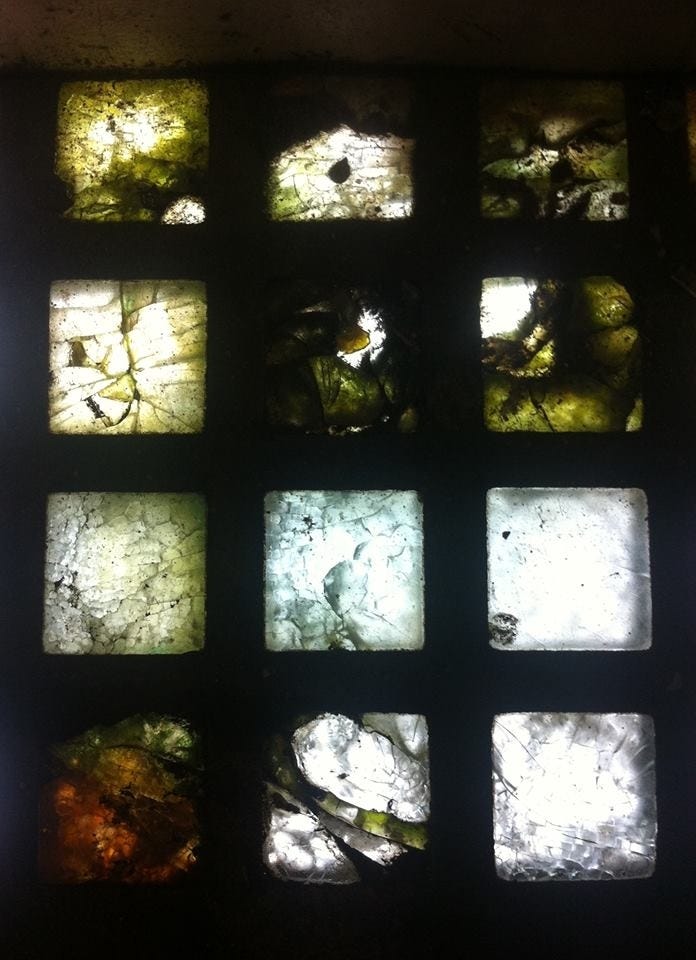This compact book of photographs and poems by Peta Lily, an exceptionally creative theatre maker, playwright, performer, poet and photographer, is a treasure. These images, floating on the left-hand pages, are more like graphic emblems than traditional photographs.
Peta’s opening stanza of her opening poem, aptly named IMPERFECTON, establishes the nature of the journey:
the broken, the chipped, the darkly lit
the submerged, the blurred, the unexpected
the torn, the sodden, the overlooked
the ancient, the underfoot
These words, fragmented like the shattered shards of the objects she photographs, reveal our malfunctioning societies. As I read through the poems and was grasped by the images, I was touched by two distinct thoughts. The first was that Peta offers an almost innocent view of our broken urban world, distressed emotionally and spiritually as it is reflected in the broken, wasted, disused, forgotten spaces, and illuminated by conflicting light that she seems to so easily see.
For me as a photographer, I try to find the perfect subject illuminated by a single shaft of window light, providing glowing highlights, sharpness and da Vinci-like sfumato. At the same time, having form revealed, not by contrasting lines, but the melding of one colour into another. Peta’s images seem to be illuminated by flat daylight, or struggling evening or night light, or by flickering florescent strips whose magenta-green conflicts always seem to be in battle with a swinging tungsten bulb hanging off the end of twisted cables, or by passing car headlights, or flickering streetlights or dusty half-dead lamps espied through basement windows, as in her image for low lights.
Whilst she presents us with her cracked but finely chiselled phrases, she continually provides the sense of a much bigger world swirling around the details she has preserved for us. In this, there is a poetry of the city with its brutal tempi, marching us off to self-destruction. At moments, I felt as if I had been lost in a 1940’s film noir. One cannot avoid the beautiful dread that fills the pages. As:
THIS WAY
never
underestimate
the comfort of direction
even
being
led
to
dread
is at least a handhold
This is the hope we can ask for. The bleakness of the poems and photographs are challenged by the strange low-tech beauty of the images that are like beautifully designed graphic stamps or seals, offering us a reminder of our venal material reality.
There is a continual enchantment of typography, broken tools, reflections and refractions through distorting glass. There are the remains of street signs, balloons and disintegrating walls and then, a huge close-up of a pineapple’s skin. The unexpected continually shout ‘wake up’, ‘see your world and then look at it’. Or ‘what the f**k is wrong with us as a species’, to live amid this broken-down world without demanding change or at least a moment of consciousness.
There is an honoured history to Peta’s work. The German artist Kurt Schwitters, despairing of existence after World War One, affected by the disharmonious anti-establishment views of Dadaism, took to collecting the detritus of his surroundings in Switzerland, assembling tram tickets, media clippings, sale’s vouchers, thrown-away cigarette packages and so forth, into striking collages; an offence to middleclass sensibilities.
Then the American photographer, Aaron Siskind: who had photographed urban life of the thirties, lived through the economic depression and World War Two and its results: millions dead and millions more destroyed for being gay, Jewish, Roma or Slavic. He had been a committed left-wing photographer, but once the war ended (and perhaps after he had learned of the holocaust) he withdrew, as did so many artists and poets, from the world of committed agit prop.
Perhaps emotionally exhausted, Siskind turned his camera to the signs of humanity rather than their actual presence, with humanity only implied. Fences, walls, doors, torn or worn posters, were his new subject matter. Humanity was present though, for the fences and walls were scratched and torn by the passing of people. The passing of people - not the coming of people, not the specific actions which form a world, but the passing; the here and now seen only as it once inadvertently may have been. Even the actions implied arbitrary moments of many hands on a door, the rubbing of many backs on a wall, events of little import, events which are always an unimportant part of life in which we live without history. Perhaps it was that the War, and in particular the holocaust which destroyed in many artists the will to confront history ever again. Or perhaps photos of human activity seemed irrelevant in the face of events so awful. In that thought, think of the post war work of Jackson Pollock, a scream of angst-ridden bewilderment.
And now there are Peta’s expressive, compellingly beautiful and seductive words and photographs. Their perceptions, their exciting combination of things: used tools, glass fragments, ripped paper, fractured typography and coalescing cultures, as in ‘soho haiku’,
are filled with enchantment, even as they warn us about our degradation. What this modest volume proves is that art, no matter the depth of despair it may reveal, is capable helping us to recognise, that within our species, there is still our capacity for life-affirming creativity.
You can purchase a copy here: YOU CAN PURCHASE THE BOOK HERE
PRICE OF THE BOOK: £4.99
Post word: Peta is a dear friend, and also a work associate over the years, and that my only connection with the book is that I designed the cover with her. You can see a film I have made of her dark clown work BELOW:







